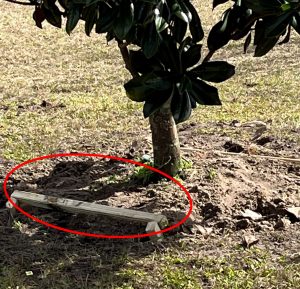As part of my duties as an extension agent, I answer a lot of questions about trees. Many times, folks are surprised that the solution that they found online was not the best one, and that sometimes it was actually harmful. It is surprising to me that in this age of having a world of information in the palm of our hands, how much misinformation there is out there. In the past I have written about some of these misperceptions about trees. However, there are so many out there that it is time to discuss a few more and where to find reliable answers
What to put in the planting hole
The first misperception has to do with what to put in the hole when planting a tree or shrub. I have read articles where it is recommended to put all sorts of products into the hole to boost plant growth. This list includes fertilizer, compost, manure, water absorbing gels, and even gravel. The reality is that none of these products will improve tree or shrub establishment. The best way to ensure proper establishment after planting is to plant it properly. This includes correcting circling roots, loosening the soil around the planting hole, planting at the right depth (a little high), filling the hole by using the native soil, providing enough water, and keeping weeds and grass away from the rootball. The reasoning behind using only native soil when planting is that we want the tree roots to grow horizontally well beyond the initial planting hole to become established. Adding amendments to the planting hole does little to accomplish this and, in some cases, can slow down tree establishment. If you wish to make amendments to the soil like incorporating organic matter, amend the entire planting site or bed around the tree, not just the planting hole. This will improve the soil that the tree roots will encounter as it becomes established. For a great publication on planting and establishing trees, go to: https://hort.ifas.ufl.edu/woody/documents/EP314.pdf.
How to stake newly planted trees

The second myth has to do with the purpose of staking planted trees. We often see recently planted trees with straps attached to the trunk anchored by stakes in the ground. This has been the standard of care for decades. The staking is applied not to hold the tree upright but to keep the tree from toppling over before it becomes established. Don’t purchase a tree if it needs to be staked to keep it from bending over. The problem with staking that is attached to the trunk, is that needs to be removed within 6-12 months after planting. We often see trees with straps imbedded in the trunk that are choking or girdling the tree. These straps were not removed as they should have been. A better way of anchoring tree root balls does not involve straps at all. Instead, the root balls are anchored in the ground by using small pieces of horizontal lumber placed on top of the root ball that are attached to stakes in the ground. This system is better able to hold trees in the ground and will not need to be removed as they will decompose over time. This novel root ball stabilization system has been used recently in tree plantings performed by the City of Jacksonville.
Hurricane pruning of palms
Finally, we come to our last misperception. This time of year, we get a lot of questions about “hurricane” pruning of cabbage, or sabal palm trees. The practice involves removing almost all the fronds leaving a small tuft at the top. To me these overly pruned palms remind me of the Muppet character Beaker. There are a couple of reasons why this commonly recommended practice is wrong. First it is not necessary. The University of Florida performed a long-term study looking at what trees were wind tolerant and what trees weren’t. It turns out that sabal palm (our State tree) ranked within the top ten wind resistant trees in the study. So why severely prune a tree that is naturally wind resistant. In addition to not being necessary, the practice of “hurricane” cutting sabal palms is detrimental to the tree. Some of the negative outcomes of over-pruning palms are:

- Reduction in the amount of food produced by the leaves, causing the trunk as it grows to get skinnier and skinnier as it grows.
- Reduced winter hardiness.
- Enhanced nutrient deficiencies.
- Spreading of disease.
With all these reasons to properly prune palms, how should they be pruned? Ideally, a healthy palm has a canopy that is almost 360 degrees around, or circular in shape. However, this is rare in our landscapes as folks feel the need to create a more formal look. When pruning, the best method would be to only prune out dead fronds. Fruit and flower stalks can also be pruned at any time. For more on palm pruning go to: https://edis.ifas.ufl.edu/publication/EP443
After reading this article you may wonder where to find research based, practical recommendations for tree care. The answer relies on how you perform your search. Including the word “extension” in your search will tap into information provided by land grant universities throughout the US. The best place to find local Florida research-based information is through a UF/IFAS source called “Ask IFAS”. You can get there by going to: https://edis.ifas.ufl.edu/ . By using these tips when performing internet research, we can be confident that the responses will be timely, practical, and based in science.
 3
3
